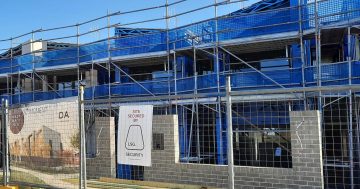
ACT builders, particularly in the booming apartment sector, have been put on notice. File photo.
The ACT’s building regulator is stepping up its actions on a number of fronts in a more aggressive approach to lifting building standards and quality.
With an Assembly committee inquiry into building quality concluding after ongoing complaints about defects and compliance, particularly in the apartment sector, Access Canberra deputy director-general Dave Peffer says builders and developers are on notice that they can expect more site inspections, tougher licence renewals and to be named and shamed on a more visible Disciplinary Register, where some of the biggest names in the industry can be found.
Last quarter, the regulator issued 13 stop work notices on site where problems had to be fixed before work can continue. In a recent blitz on certificates of occupation and use, a third failed. A crackdown on Class C licences revealed 51 per cent could not apply the ACT’s development codes, and next year these licence renewal exams will be extended to Class A and B, starting with anyone with a substantiated complaint against them.
“Wherever possible we’re looking for that proactive intervention rather than waiting for something to fail and having to rectify down the track,” Mr Peffer said.
While the majority of the industry was compliant and doing good work, Mr Peffer said the regulator would be relentless in lifting standards.
“The Government has been incredibly clear about expectations that building quality must rise, and we will drive that expectation through our regulatory interventions right through the market,” he said.
Mr Peffer says the regulator now had much more sophisticated data and intelligence than before at its disposal to target problem builders and areas, and random inspections were proving effective.
“Where our data identify where those buildings are and we have visibility of it, those builders see us many many times, and that is expensive,” he said.
The Disciplinary Register, which lists 78 offenders going back 10 years including Geocon and the Bulum Group, was now more user-friendly and easier to navigate so consumers could be better informed about who they chose to build their dwelling. Buyers can see what action was taken by the regulator such as a rectification order or licence suspension.
The regulator will be promoting the register, which is not well known, more heavily to consumers.
“One of the strongest tools we have to eliminate poor building practices is for people to stop buying from those builders,” he said.
Mr Peffer said the consumer should not look at recent work, which was more likely to be advertised, but choose buildings that have had time to show wear in areas such as render, structure and waterproofing.
Since 1 July, the regulator had received 102 building complaints in the rapidly growing strata development area, particularly for mixed-use projects, and a similar number in the planning area.
Top of the list were consumer and contracting issues, where buyers had bought off the plan, and the builder had made a number of changes throughout to the build, façade, and the quality of materials and fittings.
Mr Peffer said waterproofing remained a challenge for the industry to get right but better design was starting to make an impact so water could drain appropriately and not inside the building. More concerning were structural defects that were very costly to rectify.
Mr Peffer said one of the big challenges was poor documentation which made it hard to figure out what went wrong and how to fix a problem, “short of getting a jackhammer in there’.
Hence the blitz on certificates of occupancy and use, including site audit assessments against the plans.
The results were “pretty disappointing”, Mr Peffer said, with buildings in the ground different to what was in the plans, buildings that did not comply with the development codes, structural failings in design and delivery and even people illegally occupying buildings before a certificate had been issued.
“We will be relentlessly enforcing this until we see standards rise, we’re not going to back off,” he said.
Mr Peffer believes he has enough staff and tools to do the job.
“We identify risk and that’s where we apply resources. The sector is growing, but most of it is compliant and of reasonable quality, so the challenge is to stay ahead of the game and almost predict where we are likely to see defects, who the builders are we should targeting,” he said.
But consumers also needed to be informed.
“Consumers have a big role to play in informing themselves as much they can in what is likely to be the biggest investment of their lives to ensure what they’re buying is quality and they can have confidence in five years’ time that they’re living in a waterproof, high performing dwelling,” he said.
“People spend more time thinking about what car they’ll drive, and when you compare the level of investment, that’s an odd thing to do.
“Our role as a regulator is to make this information so accessible and so simple that really any consumer can use it to inform their decision.”





















